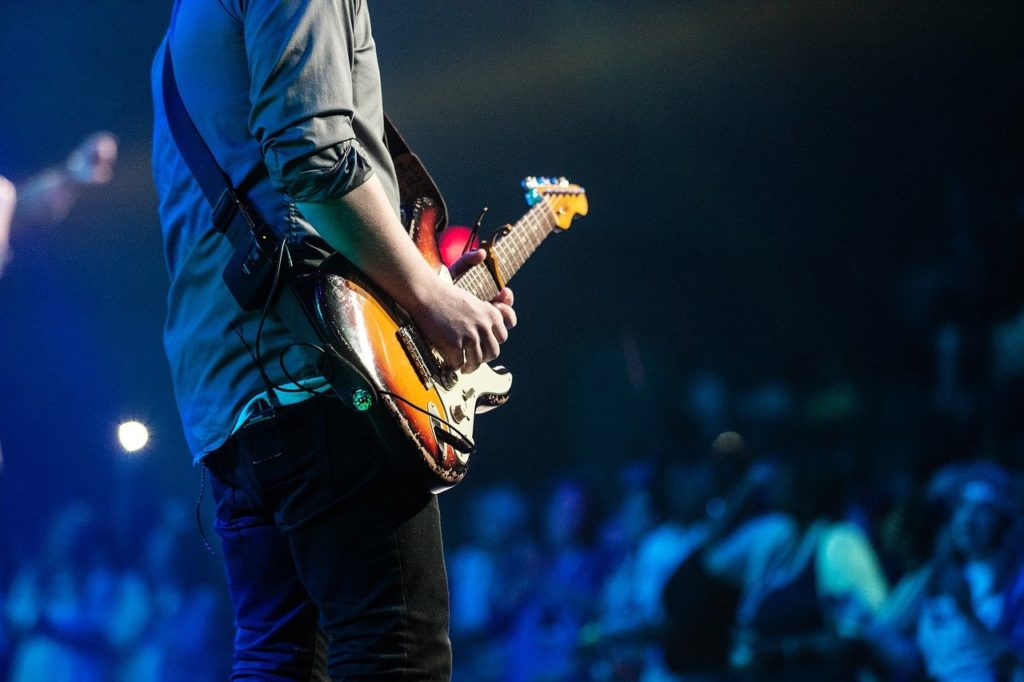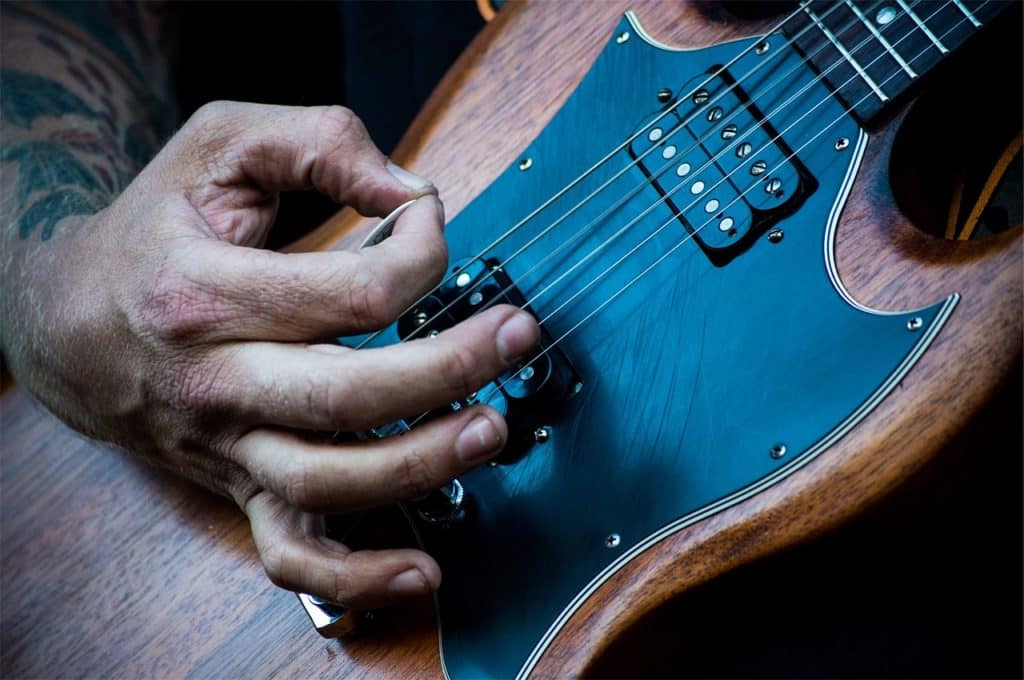The G Minor Pentatonic scale is a popular, easy to play scale used in hundreds of songs. It’s extremely popular in rock and blues genres of music and is closely related to the Blues Scale. Its simplicity makes it one of the first scales often taught in guitar lessons and contributes to its versatility.
G Minor Pentatonic Scale on Guitar
The Notes of the G minor pentatonic scale are as follows:
I -G
II-Bb
III-C
IV-D
V-F
The minor pentatonic scale is based on 5 notes of the minor scale, 1, 3, 4, 5, and 7. The minor scale being based off the major scale with a flatted 3rd and 7th.

Figure 1

Figure 2
Figure 1 shows the pattern of notes from the 1st fret to the 17th. The Root note starts at the 3rd fret on the low E string in black and all the other black dots are roots elsewhere on the neck. Figure 2 shows the notes in the first position. You can see the black dots corresponding with the Gs in the figures.
How Do You Play a G Minor Pentatonic Scale on Guitar?

Figure 3
A great place to start the process of learning any scale is in the first position. In the previous section you can see the location of notes identified on the neck and the notes labeled in the first position but that doesn’t tell you how to play it.
Figure 3 demonstrates tablature that represents how to play through two octaves in the first position in ascending and descending order. Starting on the 6th string use your index finger to fret the string at the 3rd fret, dropping your pinky finger down on the 6th fret. Continue walking your fingers down, toward the first string. You want to keep your index finger at the 3rd fret, with your ring finger on the fifth, and pinky on the 6th.
Further down the neck, towards the body, you will find occasion to use your middle finger as well. A good rule of thumb in the beginning is a finger per fret.
What Notes are in the G Minor Pentatonic Scale?
The word pentatonic comes from the Greek word for 5, penta, combined with the Latin word for sound, tonus. It’s called the G Minor Pentatonic scale because it consists of f notes of the minor scale. The 5 notes are:
- G
- Bb
- C
- D
- F
- G
For reference, the notes of the G Minor Scale are:
- G
- A
- Bb
- C
- D
- Eb
- F
- G
Interval formulas are described by how many steps they are from the previous note. This is done by stating either Whole(W), Half(H), or Whole+Half (WH). The Minor Pentatonic is formulated on WH-W-W-WH-H. A Whole step is 2 frets, and a Half step is 1 fret.
Using this formula, you can ascertain how we arrive at the notes in G Minor Pentatonic specifically. Starting with the root note G, move a WH up and you arrive at Bb, another Whole step and you arrive at C and so on until you arrive an octave higher at G.
How Do You Solo with the G Minor Pentatonic Scale?
The G Minor Pentatonic was the first scale I was ever taught in my guitar lessons and that’s why I make it the first scale I teach people when I’m lucky enough to introduce a young guitar player to the art. Hundreds of songs use the minor pentatonic scale. It’s easy and fun to play.
A simple chord progression to use as a backing track is Gm, Bb, Cm, and Dm. This is based on the popular chord progression formula of, I, III, IV, and V. Figure 4 shows the finger placement for the G minor pentatonic scale beginning at the 3rd fret.
Starting with the open position above you can use the CAGED Method to help memorize the finger placement down the rest of the neck.


Figure 5 Figure 6
Figures 5&6 show the finger placement and tablature, respectively. Using your index finger starting on the 8th ring finger falling on the 10th down until you get to the G string. Then slide your index finger back to the 7th fret and carry-on following the tablature to the E string ascending in pitch. Then work your way back up the strings descending in pitch.


Figure 7 Figure 8
Wrapping up, figures 7&8, illustrate the finger placement of the scale using the CAGED Method and figure 8 demonstrates the tablature.
Combining all these images lays out a strong foundation with which to build a solo out of. Using the backing track of the recommended chord progression and improvising on the info given from the charts you’ll be able to develop your own solos in no time.

Figure 9
You want to memorize the notes as given in figure 9 as well as the patterns given previously. Mastering the positions of the notes allows you to accentuate their place in your solos as they relate to specific chords being played when they’re being played.
G Minor Scale Theory and Summary
I often say guitar playing doesn’t have rules. That’s just a way to make playing guitar sound cooler. It depends on how you look at it. There are no rules that say you must do this or that but there is a lot of structure. Western music has been around for millennia and in all that time generation after generation has been building on it and making new connections.
In Medieval times Modes were assigned and since then we have translated those modes into scales. Whether its modes or scales there’s an interconnectivity to it all. The basic structure is built off the Major Scale, all roads lead to it, or from it. It’s like a spiderweb.
The G Minor Pentatonic Scale has a relative major of Bb. Some of the early scales you learn are extremely versatile, that’s why they’re learned first, you don’t have to be a specialist to appl them. The G minor Pentatonic Scale can be played over songs in the key of G minor, Bb, and G major. Thousands of the most famous songs in history have used the G minor pentatonic scale in them. Many of these songs are among the most searched for by just starting out guitarists to learn. A few of these are:
Songs You Can Play With G Minor Pentatonic Scale
- Shook Me All Night Long by AC/DC
- Evil Ways by Santana
- Love the Way You Lie by Rhianna
- Smoke on the Water by Deep Purple
The minor pentatonic is quite possibly the most popular solo tool in Rock and Blues music. Eric “Slowhand” Clapton himself famously uses it on some of his most popular songs. Among them are, Cocaine, While My Guitar Gently Weeps, and White Room.
If that’s not enough to get you out there learning the Gm pentatonic scale, I don’t know what will!



